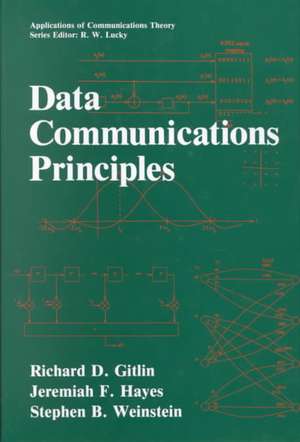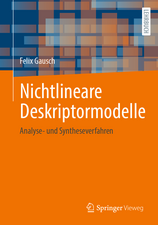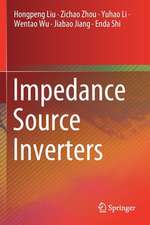Data Communications Principles: Applications of Communications Theory
Autor Richard D. Gitlin, Jeremiah F. Hayes, Stephen B. Weinsteinen Limba Engleză Hardback – 30 sep 1992
| Toate formatele și edițiile | Preț | Express |
|---|---|---|
| Paperback (1) | 1238.42 lei 6-8 săpt. | |
| Springer Us – 27 sep 2012 | 1238.42 lei 6-8 săpt. | |
| Hardback (1) | 1243.92 lei 6-8 săpt. | |
| Springer Us – 30 sep 1992 | 1243.92 lei 6-8 săpt. |
Din seria Applications of Communications Theory
- 15%
 Preț: 645.60 lei
Preț: 645.60 lei - 15%
 Preț: 641.71 lei
Preț: 641.71 lei - 18%
 Preț: 956.18 lei
Preț: 956.18 lei - 18%
 Preț: 2105.61 lei
Preț: 2105.61 lei - 18%
 Preț: 1243.92 lei
Preț: 1243.92 lei -
 Preț: 393.74 lei
Preț: 393.74 lei - 18%
 Preț: 2487.11 lei
Preț: 2487.11 lei - 18%
 Preț: 953.35 lei
Preț: 953.35 lei - 15%
 Preț: 650.86 lei
Preț: 650.86 lei - 18%
 Preț: 1228.96 lei
Preț: 1228.96 lei - 15%
 Preț: 649.39 lei
Preț: 649.39 lei - 18%
 Preț: 1392.95 lei
Preț: 1392.95 lei - 18%
 Preț: 963.77 lei
Preț: 963.77 lei - 18%
 Preț: 957.75 lei
Preț: 957.75 lei - 20%
 Preț: 337.32 lei
Preț: 337.32 lei -
 Preț: 401.79 lei
Preț: 401.79 lei - 20%
 Preț: 346.10 lei
Preț: 346.10 lei - 20%
 Preț: 341.81 lei
Preț: 341.81 lei -
 Preț: 388.13 lei
Preț: 388.13 lei - 20%
 Preț: 339.99 lei
Preț: 339.99 lei - 18%
 Preț: 962.49 lei
Preț: 962.49 lei - 18%
 Preț: 958.56 lei
Preț: 958.56 lei - 18%
 Preț: 1394.52 lei
Preț: 1394.52 lei -
 Preț: 410.07 lei
Preț: 410.07 lei
Preț: 1243.92 lei
Preț vechi: 1516.98 lei
-18% Nou
Puncte Express: 1866
Preț estimativ în valută:
238.05€ • 258.49$ • 199.96£
238.05€ • 258.49$ • 199.96£
Carte tipărită la comandă
Livrare economică 22 aprilie-06 mai
Preluare comenzi: 021 569.72.76
Specificații
ISBN-13: 9780306437779
ISBN-10: 0306437775
Pagini: 733
Ilustrații: XIX, 733 p.
Dimensiuni: 155 x 235 x 44 mm
Greutate: 1.2 kg
Ediția:1992
Editura: Springer Us
Colecția Springer
Seria Applications of Communications Theory
Locul publicării:New York, NY, United States
ISBN-10: 0306437775
Pagini: 733
Ilustrații: XIX, 733 p.
Dimensiuni: 155 x 235 x 44 mm
Greutate: 1.2 kg
Ediția:1992
Editura: Springer Us
Colecția Springer
Seria Applications of Communications Theory
Locul publicării:New York, NY, United States
Public țintă
ResearchCuprins
1. Introduction to Data Communications.- 1.0 A Perspective.- 1.1 Who Uses Data Communication?.- 1.2 Data Network Protocols.- 1.3 Data Network Architectures.- 1.4 Data Communication at Voiceband Rates.- 1.5 Carrier Systems.- 1.6 Channel Characterizations.- 1.7 Signal Processing for Data Communications.- 1.8 Organization of This Book.- References.- 2. Theoretical Foundations of Digital Communications.- 2.0 Introduction.- 2.1 Introduction to Decision Theory.- 2.2 The Additive White Gaussian Noise (AWGN) Channel.- 2.3 The Binary Symmetric Channel.- 2.4 Elements of Estimation Theory.- 2.5 Fundamentals of Information Theory.- 2.6 Channel Capacity.- 2.7 Calculations of Channel Capacity for Selected Channels.- Appendix 2A: Basic Concepts of Probability Theory.- Appendix 2B: Detection of Signals in Colored Noise.- References.- Exercises.- 3. Error Correcting and Detecting Codes.- 3.0 Introduction.- 3.1 Block Codes.- 3.2 Cyclic Block Codes.- 3.3 Performance.- 3.4 Convolutional Codes.- 3.5 Decoding Convolutional Codes—The Viterbi Algorithm.- 3.6 Performance of Convolutional Codes.- 3.7 Sequential Decoding Convolutional Codes.- 3.8 Block and Convolutional Codes Concatenated.- 3.9 Automatic Repeat-Request Systems.- References.- Exercises.- 4. Baseband Pulse Transmission.- 4.0 Introduction.- 4.1 Direct-Baseband Transmission.- 4.2 Pulse Amplitude Modulation (PAM) in a Distorted, Noisy, Bandlimited Channel.- 4.3 The Nyquist Criterion.- 4.4 Performance of Multilevel PAM with Raised Cosine Pulse Shaping.- 4.5 General Encoding Model.- 4.6 Correlative Level Encoding (Partial Response).- 4.7 Block Codes: A Multirate Digital Filtering Approach.- 4.8 Signaling on the Digital Subscriber Access Line.- 4.9 Intersymbol Interference.- Appendix 4A: Power Density Function of a Correlated LineSignal.- References.- Exercises.- 5. Passband Data Transmission.- 5.0 Introduction.- 5.1 Complex Analytic Representations.- 5.2 Linear Modulation Formats.- 5.3 Direct Inband Signal Generation.- 5.4 Multitone Data Transmission.- 5.5 Higher-Dimensional Signaling.- 5.6 Frequency-Shift Keying.- 5.7 Trellis-Coded Modulation.- 5.8 Conclusion.- References.- Exercises.- 6. Synchronization: Carrier and Timing Recovery.- 6.0 Introduction.- 6.1 Optimum (Maximum Likelihood) Carrier Phase Estimation.- 6.2 The Phase-Locked Loop (PLL).- 6.3 Carrier Recovery: Non-Data-Aided Systems.- 6.4 Carrier Recovery: Data-Aided Systems.- 6.5 Timing Recovery.- 6.6 Joint Carrier and Timing Recovery.- 6.7 Periodic Inputs and Scramblers.- References.- Exercises.- 7. Optimum Data Transmission.- 7.0 Introduction.- 7.1 Maximum Likelihood Sequence Estimation (MLSE): The Viterbi Algorithm.- 7.2 Whitened Matched Filter Receiver.- 7.3 Suboptimum MLSE Structures.- 7.4 The Optimum Linear Receiver (Equalizer).- 7.5 Decision Feedback Equalization.- 7.6 Chapter Summary.- Appendix 7A: The Wiener—Hopf Decision Feedback Equation.- References.- Exercises.- 8. Automatic and Adaptive Equalization.- 8.0 Introduction.- 8.1 Scope of Equalization Applications.- 8.2 Baseband Equivalent System.- 8.3 Minimization of the Mean-Square Error by the Gradient Algorithm.- 8.4 The Least-Mean-Square (LMS) Estimated-Gradient Algorithm.- 8.5 Fast Convergence via the Kalman (Recursive Least-Squares) Algorithm.- 8.6 Fast Kalman Algorithms: Kalman Algorithms with Reduced Complexity.- 8.7 Lattice Filters: Another Structure for Fast-Converging Equalization.- 8.8 Tracking Properties of the LMS and the Recursive Least-Squares Algorithms.- 8.9 Complexity Comparison.- 8.10 Cyclic Equalization.- 8.11 Zero-Forcing Equalization.- 8.12 PassbandEqualization.- 8.13 Joint Optimization of Equalizer Tap Coefficients and Demodulation Phase.- 8.14 Adaptive Cancellation of Intersymbol Interference.- 8.15 Blind Equalization.- 8.16 Chapter Summary.- Appendix 8A: Convexity of the Mean-Square Error.- Appendix 8B: Asymptotic Eigenvalue Distribution for the Correlation Matrix of Synchronous and Fractionally-Spaced Equalizer.- Appendix 8C: Derivation of the Matrix Inversion Lemma.- Appendix 8D: Tracking Properties of the LMS and RLS Algorithms.- References.- Exercises.- 9. Echo Cancellation.- 9.0 Introduction.- 9.1 The Dialed Telephone Circuit Echo Cancellation Model.- 9.2 The Echo Cancellation Model for Digital Subscriber Lines.- 9.3 FIR (Tapped Delay Line) Canceler Structures.- 9.4 Other Canceler Structures.- 9.5 Passband Considerations.- References.- Exercises.- 10. Topics in Digital Communications.- 10.0 Introduction.- 10.1 Effect of Digital Implementation on the Performance of Adaptive Equalizers.- 10.2 Adaptive Carrier Recovery Systems.- 10.3 Signal Processing for Fiber-Optic Systems.- Appendix10A: A Comparison of the Quantization Error (QE) of a Fixed Equalizer with the Achievable Digital Residual Error (DRE) of an Adaptive Equalizer.- Appendix10B: The Effect of Linear Equalization on Quadratic Distortion for Lightwave Systems.- References.





























